This is a Canon 110ED 20, a compact rangefinder camera that used 110 format Instamatic film. The Canon 110ED 20 was an updated version of the earlier Canon 110ED from 1975, improving the shutter by adding a top 1/1000 shutter speed and adding support for new ASA 400 speed film. Featuring automatic exposure, a fast 5-element 26mm f/2 lens, a coupled coincident image rangefinder, and a shutter with a wide range of speeds, the Canon 110ED 20 bucked the trend of cheap 110 Instamatic cameras, and was a very capable photographic instrument. As one of the only cameras in it’s segment, it offered the flexibility and quality of much larger cameras, but in a compact, pocket sized body.
Film Type: 110 Pocket Instamatic Film
Lens: 26mm f/2 Canon Lens coated 5-elements in 4-groups
Focus: 2 feet to Infinity
Viewfinder: Coincident Image Coupled Rangefinder
Shutter: Electronically Controlled Behind the Lens Shutter
Speeds: 2 – 1/1000 seconds, step less, 1/125 mechanical
Exposure Meter: Silicon Photo Diode w/ Aperture Priority AE
Battery: 6v 4LR44/PX28 Alkaline Battery
Flash Mount: Hot Shoe w/ 1/125 x-sync
Weight: 316 grams
Manual: https://mikeeckman.com/media/Canon110ED20Manual.pdf
How these ratings work |
The Canon 110 ED 20 is from a very small niche of “premium” 110 cameras which upgraded what was usually an entry level and basic format with a high quality and fast 5-element f/2 lens, a wide range of shutter speeds, a coupled rangefinder, and aperture priority automatic exposure. The Canon 110ED 20 does it’s best to make the most of the tiny 110 format, but the resulting images didn’t look much different from other, cheaper, 110 cameras I’ve seen. The camera wasn’t any better or easier to use than simpler cameras, and at a price quite a bit higher than most 35mm cameras of the day, I am not sure who it’s target customer was. | ||||||
| Images | Handling | Features | Viewfinder | Feel & Beauty | History | Age | |
| 1 | 1 | 2 | 2 | 1 | 1 | 0% | |
| Bonus | +1 for a premium feature set in an otherwise dull camera | ||||||
| Final Score | 9.0 | ||||||
History
The Eastman Kodak Company has a long history of messing with winning formulas when it comes to available film formats. Ever since the very first Kodak camera from 1888 and it’s then revolutionary new type of roll film, Kodak never went long without releasing something new.
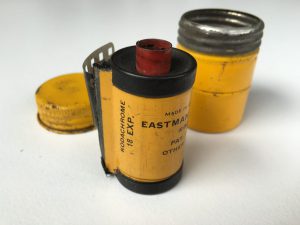
In the early 20th century, Kodak produced over 30 different film formats in all sizes and lengths, some for just a single model of camera. In 1934, when Kodak released their new Type-135 Daylight Loading Cassette, they seemed to slow down as their new 35mm format quickly caught on as the dominant type of “miniature” film for professionals and amateur’s alike.
By the end of World War II, type 135 film was the most successful film format in any size, and Kodak led the industry in film production. As we know today, that didn’t stop them from trying to keep improving upon the same formula. With competing formats such as AGFA’s Karat and later Rapid film formats, Kodak strove to find ways to improve upon 35mm, making it easier to load, and in 1963 Kodak would release Instamatic film, a new type of 35mm film in which both the supply and take up sides were self contained in a plastic cassette.
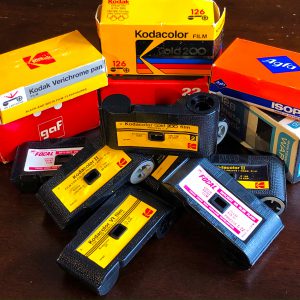
Loading Instamatic film would be fool proof as the user only had to open a door in the back of the camera, drop in a cassette, close the door, and let the camera do the rest. Unloading was just as easy, as once you reached the end of the roll, you pulled out the entire cassette and your exposed film was already protected inside.
Although Instamatic film was easier to use, it wasn’t any smaller than regular 35mm film, and it failed to catch on in large numbers with advanced amateur and professional photographers. Where Instamatic was successful was in the entry level market. Cheap cameras that offered fully automatic operation, easy to use controls, and simple designs were the preferred option, but with cameras that rivaled the size of a regular 35mm, Kodak thought that perhaps Instamatic could become more appealing to the beginning photographer if the film was smaller, allowing for much smaller cameras.
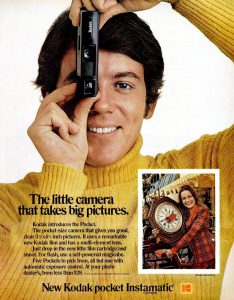
In 1972, Kodak would release their new format, which was given the name 110-format, which is strange as a previous, and completely unrelated 110 format had existed between 1898 to 1929. The new 110 was nicknamed “Pocket Instamatic film” as that was the name given to the first cameras that used it. The new film was basically just a smaller version of regular Instamatic film, sharing a simpler plastic cassette in which paper backed film traversed from a supply to take up side when advanced through the camera.
The film inside was 16mm wide, which was chosen as that meant it could be processed using the same types of machines and spools that already existed for double-8mm and 16mm cinema film formats. Exposures made using 110 film were 13mm tall by 17mn wide and used a single perforation for the camera to know exactly where to begin and end each exposure.
With images that are roughly one quarter the size of regular 35mm film, the exposed image area contained much less detail in the exposures made on it, but that didn’t stop a few companies from taking up the challenge to produce high end lenses that could maximize detail in the tiny images.
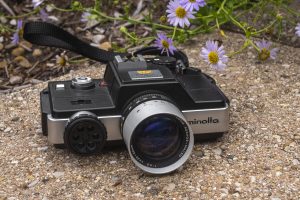
Companies like Minolta, Pentax, Rollei, Voigtländer, and Canon all produced high end 110 SLR and rangefinder cameras with sharp lenses that could make images suitable for small enlargements.
Minolta took the opportunity afforded them by a smaller film format and eschewed the traditional design of an SLR, coming up with the strange looking Minolta 110 Zoom SLR to the left. Featuring a reflex mirror allowing through the lens composition and focus, automatic exposure, and quality Rokkor lenses, these cameras attempted to prove that small images do not mean bad images.
Canon took a more conservative approach, and rather than come up with an all new design, in 1975 released the Canon 110ED which had a thin rectangular body, similar to Kodak’s Pocket Instamatic cameras, but added in as much technology as they could, with aperture priority automatic exposure, a coupled coincident image rangefinder, a high quality 5-element f/2 Canon lens, and an integrated date imprint feature (there was a Canon 110E without the date feature).
Shortly after it was released, in their August 1975 issue of Modern Photography, the Canon 110ED was given the three page test shown below. The article starts off by saying that the magazine had avoided 110 cameras to that point as they had a requirement for them to bother testing one, it had to be a serious camera worthy of competing with others in the market. It continues by championing the camera’s build quality and fine brushed chrome appearance. The fast f/2 lens was one stop faster than any lens available on a 110 camera at the time, and that the availability of a coupled rangefinder and automatic exposure made it pleasant to use. Lens sharpness was rater from Good to Excellent at the corners and Very Good all around in the center, even wide open. Finally, the shutter had a single mechanical 1/125 speed, meaning you weren’t completely dead in the water in the event the battery were to die.
Two complaints about the contrast of the rangefinder patch and the closeness of the controls for the date imprint feature were the only negatives to be found but otherwise the tone of the review was very positive, even ending it by saying that with cameras like this, 110 film may one day give 35mm a run for it’s money.
When Kodak first released 110 film in 1972, it was only available in a single speed, ASA 80, but in time, faster speeds were released, requiring some updates to the metering system found on metered 110 cameras. As a result, in 1977 Canon would release an updated model called the Canon 110ED 20 with an updated shutter with a top speed of 1/1000 and the ability to detect and meter for new ASA 400 speed films. Otherwise, the rest of the camera’s specs and appearance was the same.
The following dealer brochure for the Canon 110ED 20 is courtesy Pacific Rim’s Reference Library and shows how the camera was marketed to dealers.
Although no price is listed in this brochure, I’ve seen it mentioned elsewhere sold in a clamshell display case with the camera, Canonlite ED flash, and flash extender for $199.50, which was $10 more than the earlier 110ED model. In the dealer catalog above, both the flash and flash extender have separate part numbers suggesting they were available separately, also suggesting that perhaps the camera could be bought by itself without the kit, at a lower price.
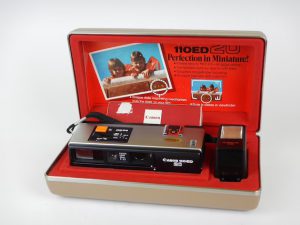
Selling the camera in a case with a purpose designed flash was consistent with Canon’s desire to make the camera appealing to more skilled photographers as by the mid 1970s, having a flash option was essential. Although the list price was $199.50, it likely had a retail price quite a bit cheap, possibly as low as $149.99, which if true compares to around $650 today.
I was unable to find any information about how well the 110ED or 110ED 20 sold, but my best guess is poorly as I don’t believe there was a lot of demand for nearly $200 Instamatic cameras. Although the camera did appear to be available from back of magazine dealer ads into the early 1980s, it seems as though other premium 110 cameras had relatively short lives, plus, according to Canon’s Camera Museum, after the release of the 110ED 20, Canon would never again make a 110 camera, instead focusing on their compact 35mm point and shoot models.
Instamatic 110 film cameras enjoyed success in the 1970s with a wide range of entry level and advanced cameras, but by the 1980s, as 35mm point and shoots continued to get smaller and smaller, plus featuring easier “quick load” systems, the appeal of 110 cameras and it’s 13mm x 17mm images size waned. Premium models like the 110ED 20 disappeared, leaving only the simplest models on dealer’s shelves.
The Kodak Ektralite 10 would be one of the last 110 cameras sold when it was discontinued in 1994. Kodak would end production of 110 film around 2005, and Fuji in 2009. The absence of fresh 110 film options would be short lived however, as in 2011, the Lomography Project would restart production of several different varieties of 110 film, continuing it’s production to the present, making them the largest producer of new 110 film in the world.
Today, there is a small demand for 110 cameras as their compact size and lo-fi look is appealing to those who are being re-introduced to film. Premium models like the Canon 110ED 20 and both Minolta and Pentax’s 110 SLRs are sought after too, for the above average results you can get from them. With the uncommon combination of a coupled rangefinder, auto exposure, and a fast and sharp f/2 lens, you could do a lot worse than the Canon 110ED 20.
My Thoughts
I grew up in the 1980s so I remember seeing many people with these candy bar sized 110 cameras. I even had one with a rubberized blue and yellow body that was made by Fisher Price for children and I remember taking it with me to auto shows and other things where I would pretend to be my dad shooting my own pics.
Since I’ve started collecting cameras, I’ve learned that although there were a great deal of really basic models, that there were also a few decent ones. I actually own two of the Minolta 110 SLRs, but never got around the shooting them because the film isn’t easy to come by, and it’s even harder to develop at home as you need dedicated 16mm reels and tanks.
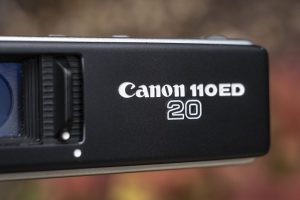
Last year, when I created the Eleven Unfortunately Named Cameras article, the Canon 110ED made it on the list so I could poke fun at it’s use of the letters “ED” which today is more commonly associated with “erectile dysfunction”. At the time, I didn’t actually have a camera though, so I wrote a few paragraphs making fun of it, and left it at that, but as fate would have it, later in 2020 a nice looking Canon 110ED 20 would come my way in a big lot of cameras. This one was the later “20” model which added support for ISO 400 films, and also upped the top shutter speed to 1/1000.
When the Canon 110ED 20 arrived, I was immediately impressed with it’s heft and build quality. Although only weighing 316 grams, it’s small form factor gives the impression of density that cheap quality light weight cameras lack. Of course having a coupled rangefinder, an f/2 lens, automatic exposure, and a date back feature, the camera doesn’t look like a cheap model on paper, and it certainly doesn’t feel like it in use.
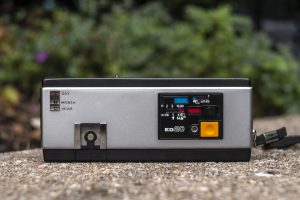
Up top, the Canon 110ED 20 has quite a lot going on. On the far left is the display for the date imprint feature, showing Day, Month, and Year. Like all date back cameras of the era, the range of years are limited to what the manufacturer likely thought the useful life span of the camera would be. The following choices are available:
- Day – 0, 1 – 31, and Blank
- Month – 0, 1 – 12 and Blank
- Year – 0, 1 – 9, 79 – 89, and Blank (the original 110ED had years 77 – 87)
Next is the flash hot shoe which most likely would have been used with the Canolite ED flash that the camera was almost always packaged with, but it would work with any number of electronically synced flashes. The maximum flash sync speed is 1/125 seconds.

Next are all of the camera’s controls for exposure, focus, and the shutter release. The top control with the blue background controls the aperture. Although f/stops are not listed, four click stops, indicated by an icon of a window/flash signal, Cloud, Sun, and small dot correspond to f/2, f/4, f/8, and f/16 respectively.
Below it is a second control with a red background for focus. Focus distances from 0.6 meters to infinity are indicated along with some icons, but the focus control is coupled to the rangefinder visible in the viewfinder, so there really is no need to look at the distance scale. Even if you wanted to, the scale is very small and difficult to get an accurate distance. The left to right motion of the focusing slider is smooth and nicely dampened, with just the right amount of resistance to prevent accidental changes to the focus distance.
Finally, at the bottom is the large orange shutter release button, with a threaded cable release socket to it’s left. The Canon 110ED 20 lacks a shutter setting for Bulb, but with a minimum shutter speed of up to 2 seconds, when mounted to a tripod, the ability to use a cable release is a nice touch.
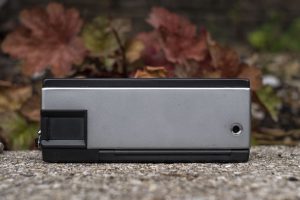
The bottom of the camera has the film advance slider, which is located in a convenient location for your right thumb, and allows you to both advance the film and cock the shutter in one smooth motion. Opposite the film advance is the 1/4″ tripod socket, which although not centrally located, probably wasn’t used much.
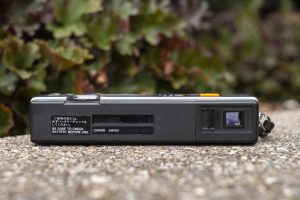
The camera’s back has a warning sticker to check the battery before shooting and another with the camera’s serial number on it.
Above the serial number is a clear window which was used on all 110 film cameras, allowing you to see the back of the cassette which shows you what kind of film is loaded, but more importantly, how many exposures have been made. 110 film uses a paper backing with exposure numbers written on it which eliminates the need for an exposure counter to be present on the camera itself.
Off to the right is the door release for gaining access to the film compartment and the eyepiece for the viewfinder. There is no lock, preventing you from accidentally opening the film compartment with film loaded, so be careful.
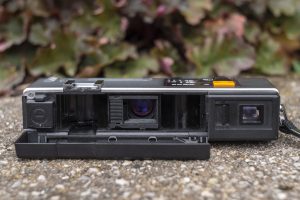
Opening the rear door reveals the film compartment. As 110 film is a completely self-contained cassette, there is no need to thread film onto a take up spool. Simply drop a new cassette into the chamber and close the door to complete the loading process. As the film cassette itself does a pretty good job of preventing light leaks, there are no additional foam light seals on the camera to worry about having to replace.
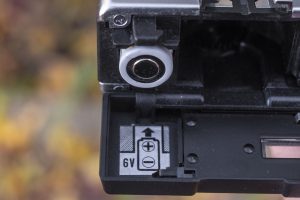
In addition to the film compartment, the rear door also covers the battery compartment for the single 6v 4LR44 battery. Since the battery compartment is inside the film compartment, if it were to die, you’d have to open the camera in darkness and replace the battery to prevent ruining your film.
Finally, also note the large size of the rear element of the f/2 lens. Since most 110 film cameras used slower and much simpler lenses, it is not common to see such a large piece of glass in here.
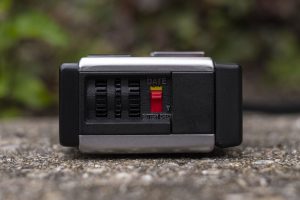
The only other controls on the camera are for the date back on the camera’s left side. Three black wheels control the Day, Month, and Year displays seen on the top of the camera. A switch which turns the date imprint feature on and off also doubles as a battery check button. Press down and hold this switch and look for a light to glow in the viewfinder to confirm the camera has enough power to operate.
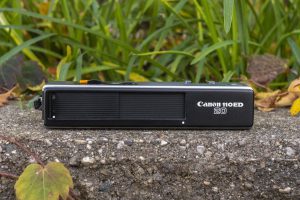
The Canon 110ED 20 doesn’t have a proper power switch as the camera only uses power when the meter is activated with a half-press of the shutter release, but you can effectively lock the shutter release by sliding a black protected cover over the lens on the front of the camera. This door should be used when storing the camera, not only to prevent accidental exposures, but also to protect the front of the lens.

The Canon 110ED 20’s viewfinder features a coupled coincident image rangefinder that works the same as those found on 35mm rangefinder cameras. Move the focus selector left and right to line up a double image in the center of the viewfinder to achieve perfect focus. The viewfinder uses a purple filter along with yellow tinted rangefinder patch and projected frame lines. The frame lines indicate the visible image which will be captured by the lens, along with manual parallax correction marks for close focus. A yellow warning light on the left is a camera shake light for slow speeds, and a red light on the right is an overexposure indicator. The example here had a small amount of haze on the beamsplitter, which reduced contrast somewhat, but it was still easy to use, even in low light.
If the date imprint feature is enabled, the exact combinations of Day, Month, and Year that will be imprinted onto the film will also be visible within the viewfinder which is a good reminder to turn it off if you don’t want to use that feature. In the previous image to the right, I have the feature on.
Besides two LEDs on opposite sides of the viewfinder which indicate a slow shutter speed on the left, and an overexposure indicator on the right, no other information about exposure is visible in the viewfinder.
The Canon 110ED 20 is certainly an interesting camera, and one of the few high specification non-SLRs to use the 110 format, but what would it be like to shoot? Does the faster lens and convenience of auto exposure and a coupled rangefinder make this a game changer for compact film formats? Keep reading…
My Results
My first roll of film in the Canon 110ED 20 was a fresh roll of Fukkatsu 400 Color that I picked up from the Film Photography Project store. Not having shot any 110 film since the 1980s, I was excited to get out and try this format again. As I do with most general purpose films, I carried the camera with me and used it as a point and shoot, likely how most owners would have when it was new.
I left the date imprint feature off for most of the roll, but did have it on for the covered bridge photo. While this isn’t something I likely would have used often, it definitely would have come in handy back in the days when people made prints of photos and cataloged them into family photo albums.
This being the first 110 camera I’ve shot in probably over 30 years, I didn’t know what to expect, but after developing what was supposed to be fresh 400 speed film, I was a bit disappointed at what looked to be an entire roll of underexposed images. This being an automatic camera, even if I had picked an inappropriate f/stop, the meter should have compensated with a correct shutter speed, so I wasn’t too sure what had happened, so to eliminate user error, or that something had gone wrong in developing, I ordered a second roll of film, this time black and white 100 speed Fukkatsu. I figured if both rolls came out underexposed, I would just chalk it up to the camera being old and move on.
I am just going to throw this out there…I am not a fan of 110. I know this was a format that was designed to be cheap and easy to use. The overwhelming majority of 110 cameras were inexpensive models sold to people who merely wanted to capture moments, with little disregard for image quality.
The Canon 110 ED 20, along with other “premium 110″ cameras like the Minolta 110 Zoom SLR and Pentax Auto 110 Super are outliers in that they attempted to upscale a fundamentally low scale format. Sure, 4×6 and maybe even 5×7 enlargements can be made from these images that will appeal to most people. The size of my 27” computer monitor is significantly larger than the prints these camera likely made, revealing pebble sized grain and a softness that you’d only get by zooming into a 35mm negative by a factor of 10, but combined with a lack of many good film formats, plus additional challenges with developing, shooting this camera is a high effort/low reward proposition.
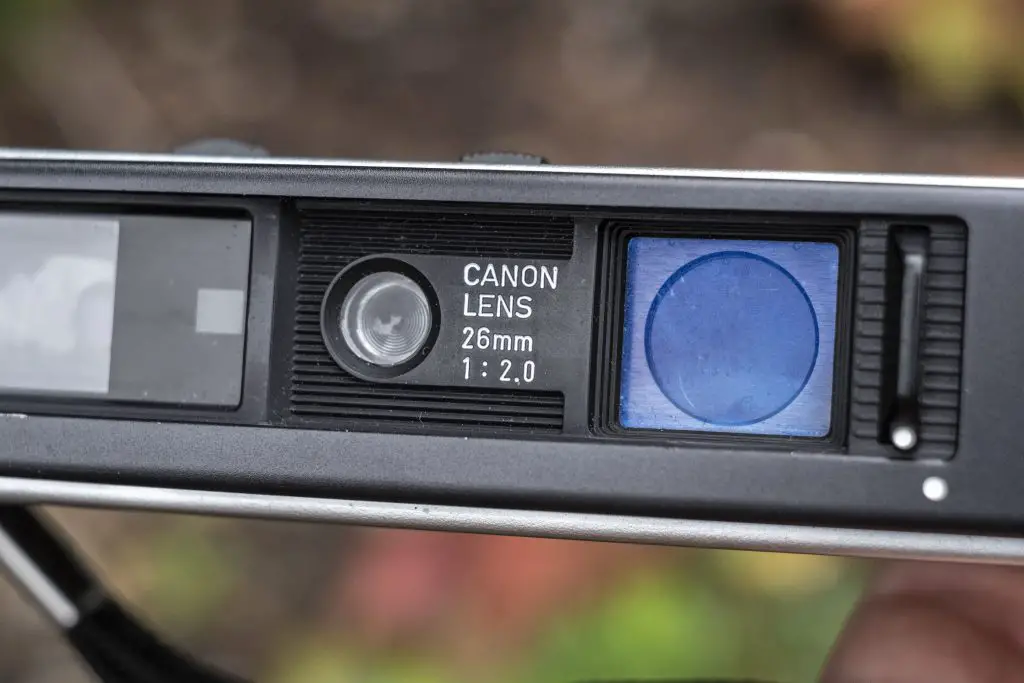
The 5-element Canon f/2 lens probably produces good image quality, but it’s difficult to see with all the grain in these images. I will say that sharpness does appear to be consistent corner to corner, and I see no vignetting in any of the images, even those where the sky is present, but whether these look noticeably better than those possible with a lower spec 4, 3, or even 2 element lens is anyone’s guess. Perhaps if finer grained films like Kodak TMax or Portra were available in 110 format, we might see more detail.
In my research for this article, I wondered if any ambitious film hacker decided to take apart a Canon 110ED and remove the lens and try it digitally, and a quick Google search returned an old thread on dpreview where someone did that very thing. There’s only a single sample image that shows excellent center sharpness, but some crazy soap-bubble bokeh around the edges which I find strange as I saw no such thing while shooting the camera.

A second search on Flickr returned an album with more adapted Canon 110ED images, all showing the same distinct out of focus details.
I do think that there is an issue with the metering system on this camera, but the fact that this is an electronic camera that only fires at 1/125 without power and I used this camera in a variety of exposure situations, I have to imagine the meter and shutter were working, but I’ll never know as there is no feedback from the camera while shooting.
I wish I could even say that with a properly working Canon 110ED and some better film, that I would have enjoyed shooting it, but I didn’t. I found the candy bar shape with the viewfinder located on the extreme right edge to be very awkward to hold. Being a left eye shooter, I had to hold the camera almost to the complete side of my head. Even if I used my right eye, I don’t think that any amount of continued use would have made this a comfortable camera to hold. I understand the location of the film compartment sorta eliminates any chance at a centrally located viewfinder, but I wonder how that might have felt.
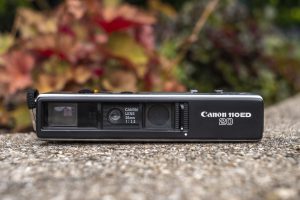
I am clearly not the target customer for a camera like the Canon 110ED 20, but I really have to wonder who was. At the prices these sold for, you could have bought a much better 35mm point and shoot that wouldn’t have been much larger, but would have produced significantly better looking images. I guess that’s why after this camera, Canon never made another 110 camera.
Perhaps I’m being a bit harsh though, after all, I’ve been reviewing strange cameras with tons of quirks, some not very successful, and been much kinder than I am being to this one. Compared to other 110 cameras, the Canon 110ED 20 is built well, has some compelling features, and is technically capable of making good images., so for that, it deserves it’s place in camera history as an short lived attempt at producing a premium low end camera.
If you want to add one of these to your collection, I won’t stand in your way. They are neat, and if you can get one in it’s original display box, they do look cool. Just make sure that if you accept the challenge of locating 110 film, shooting the camera, and getting it developed, that you have realistic expectations, because I don’t think I did.
Related Posts You Might Enjoy
External Links
https://global.canon/en/c-museum/product/film97.html
https://www.35mmc.com/19/03/2021/canon-110ed-a-mini-review/
http://quirkyguywithacamera.blogspot.com/2018/04/small-format-size-big-format-results.html
https://basepath.com/ClassicCameras/grid.php?id=17674450&key=hr6VXt
https://www.autoweek.com/car-life/a1715621/high-quality-110-film-camera-visits-junkyard/

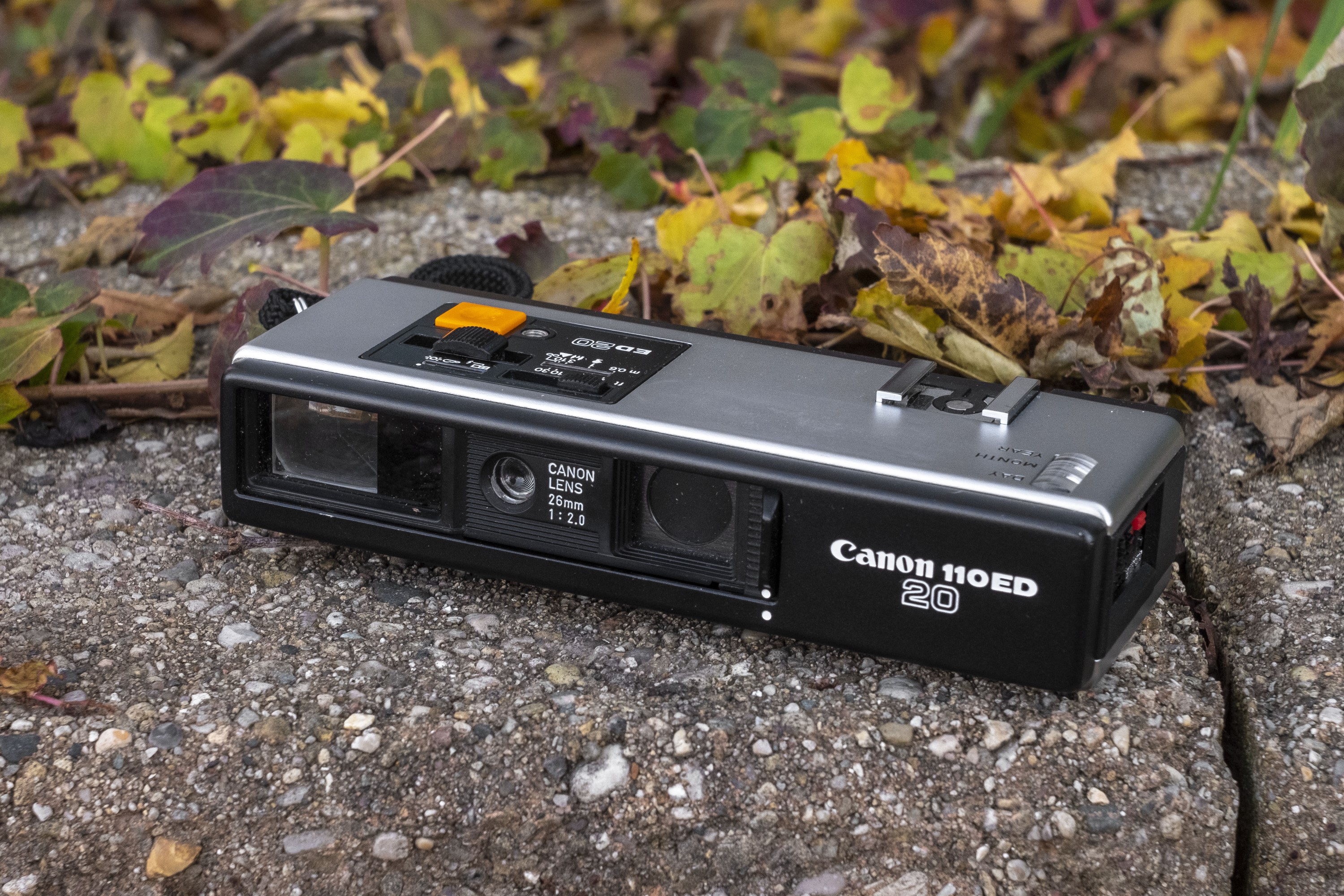
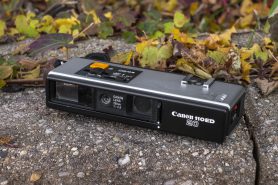
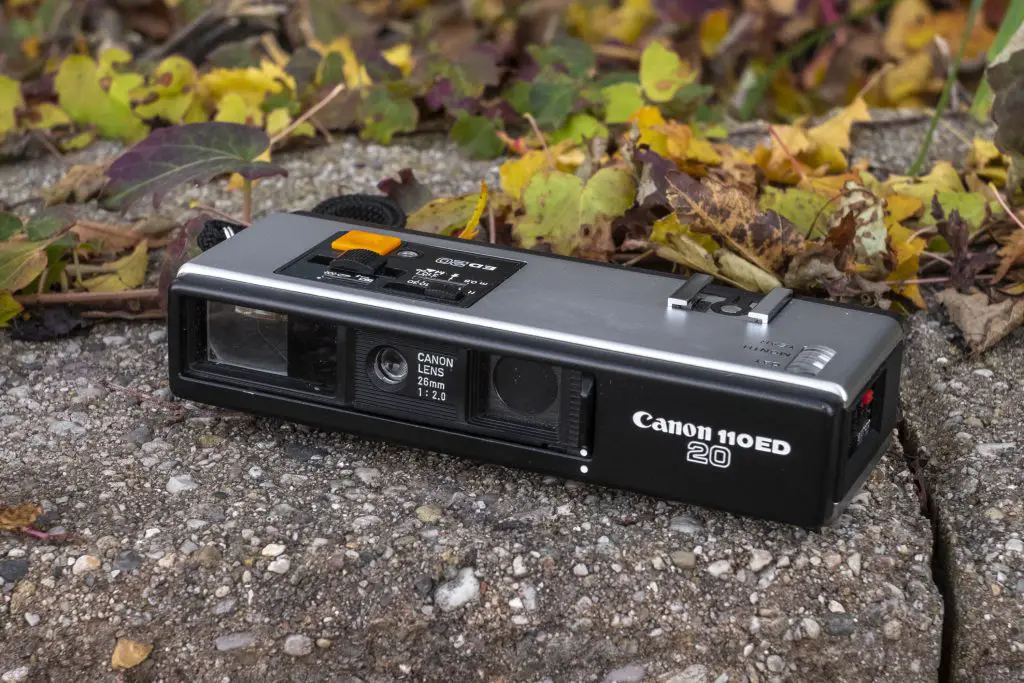
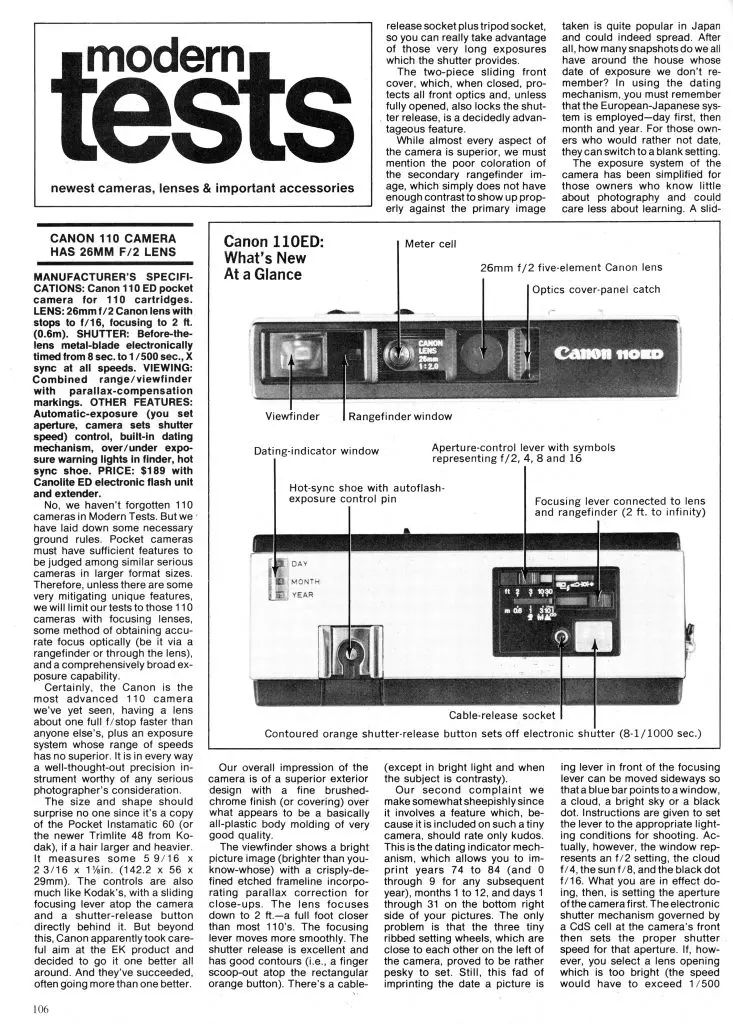
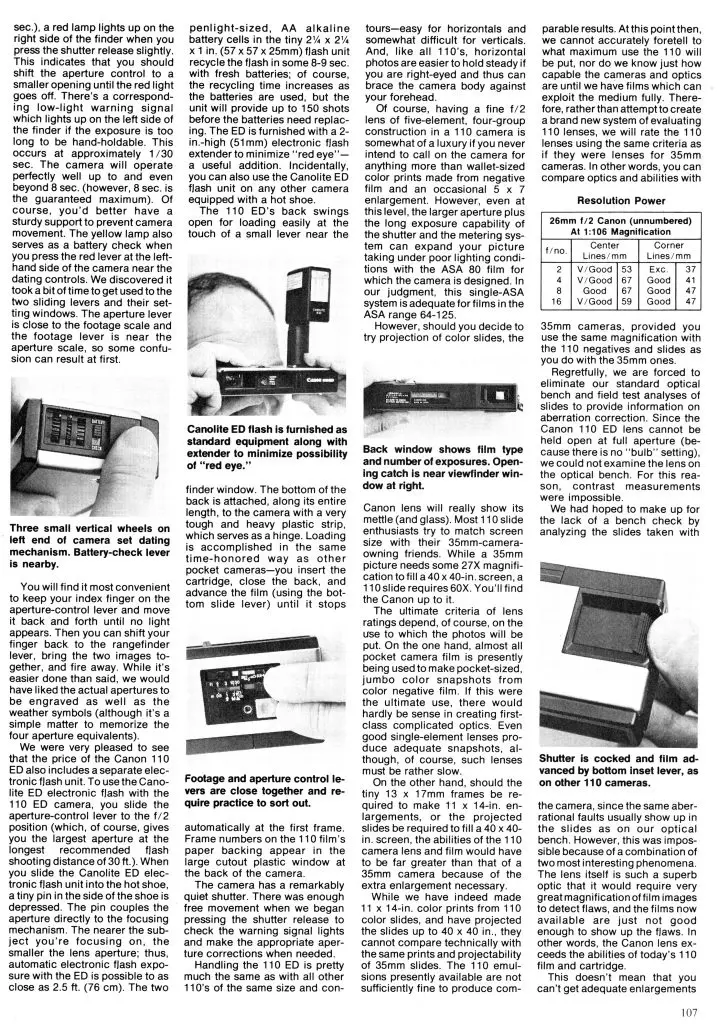
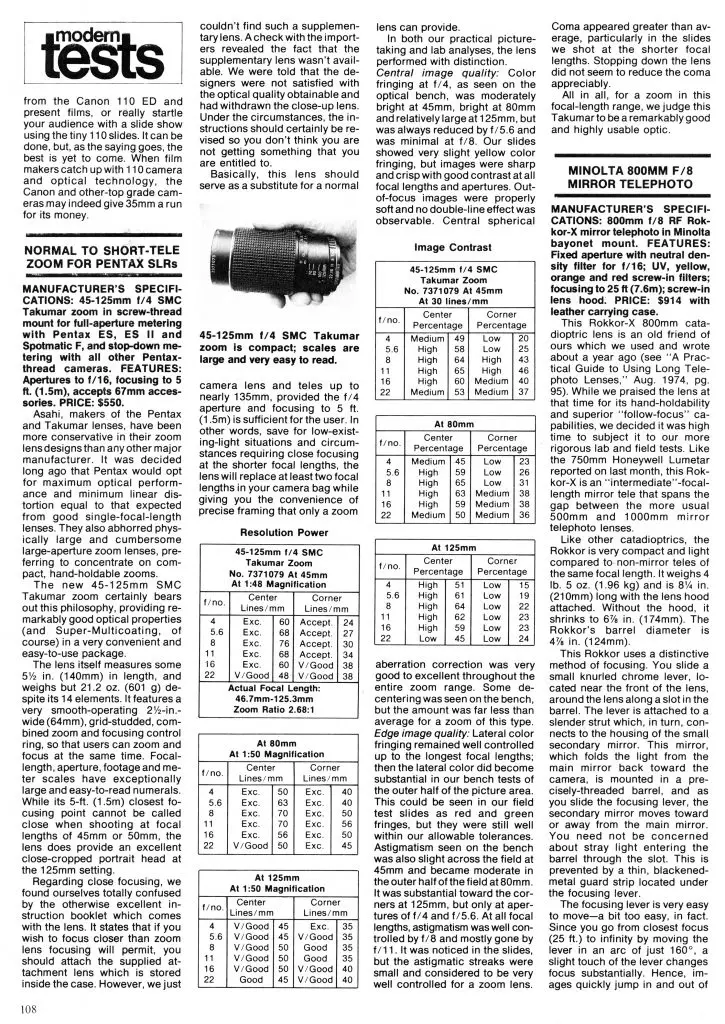
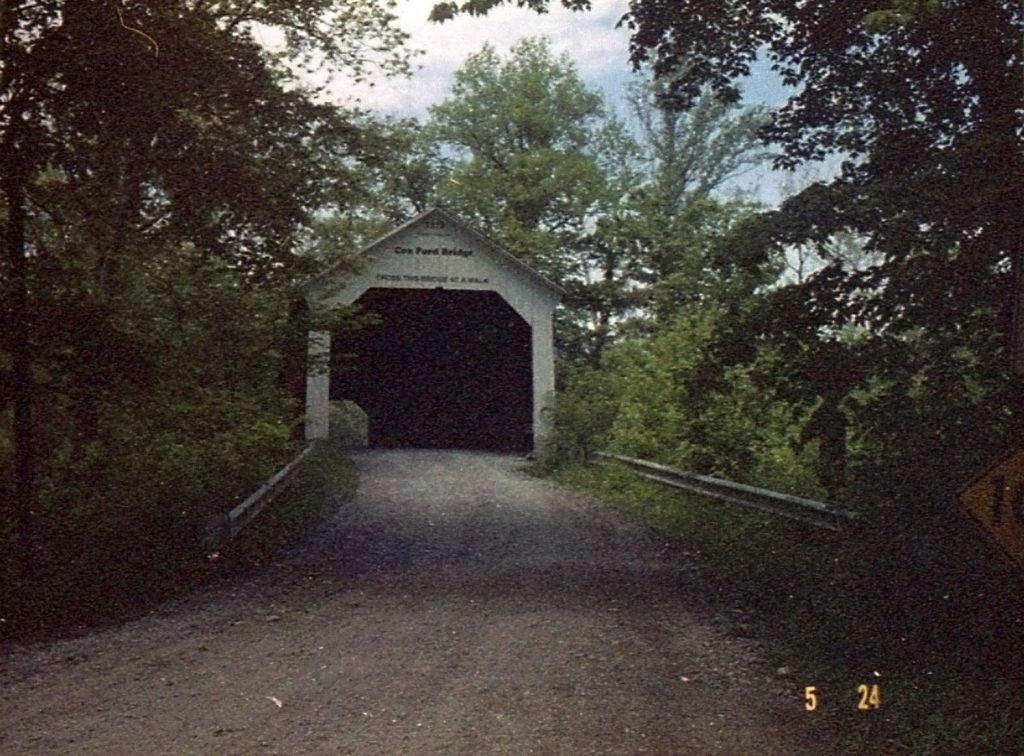

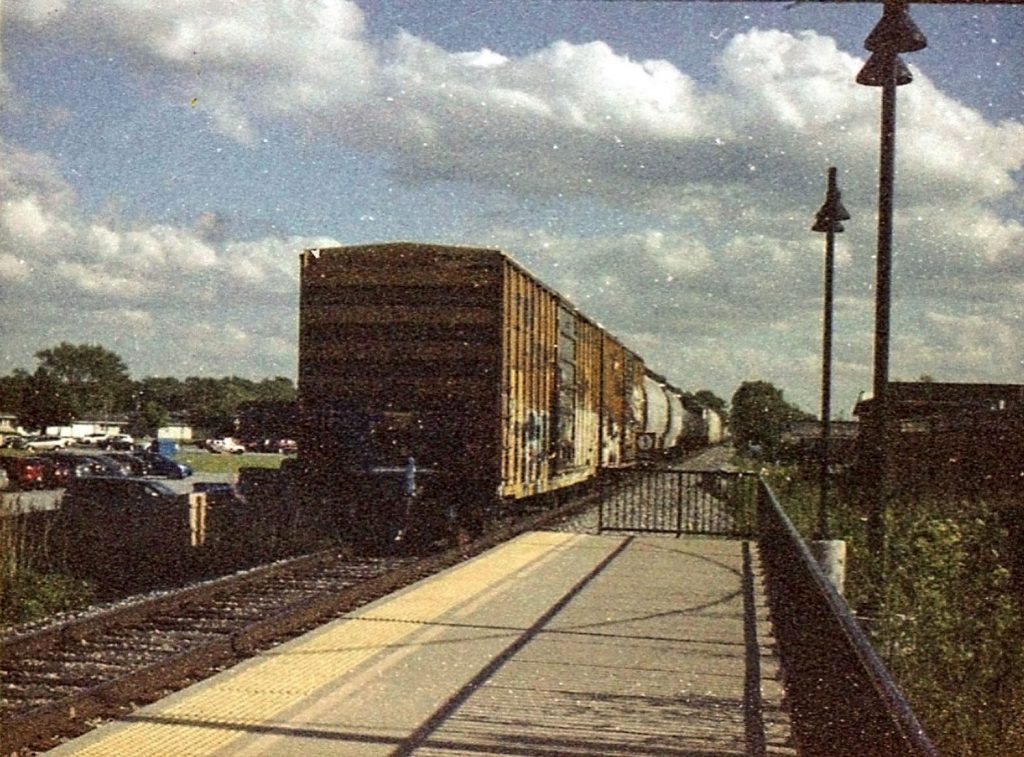
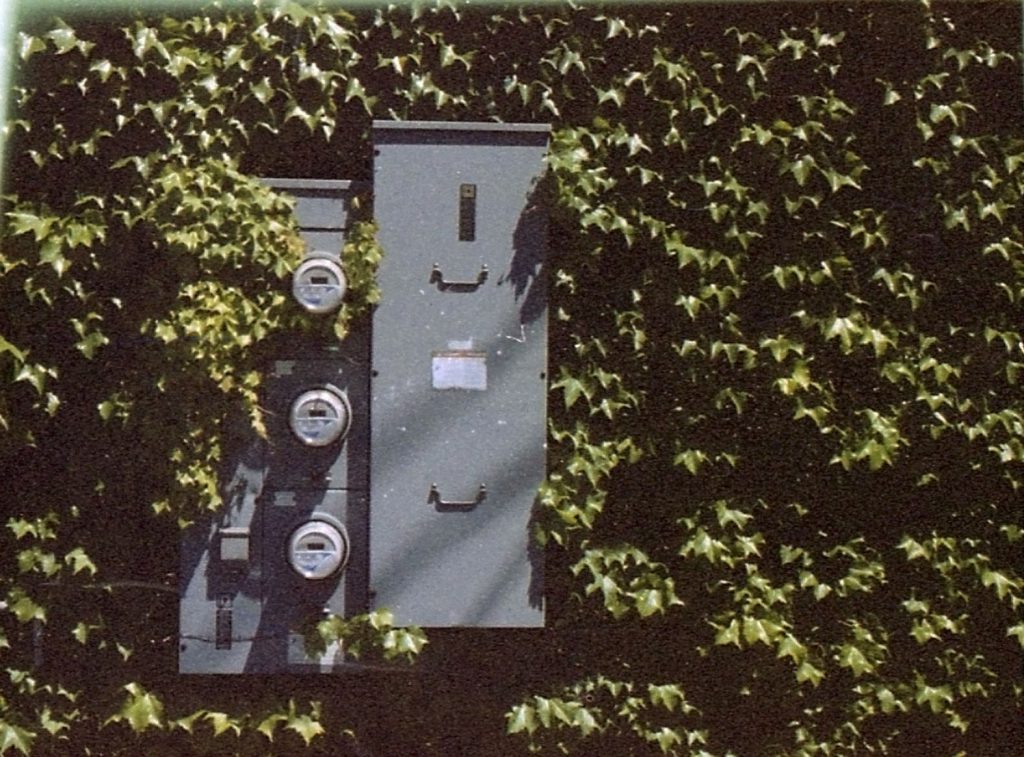
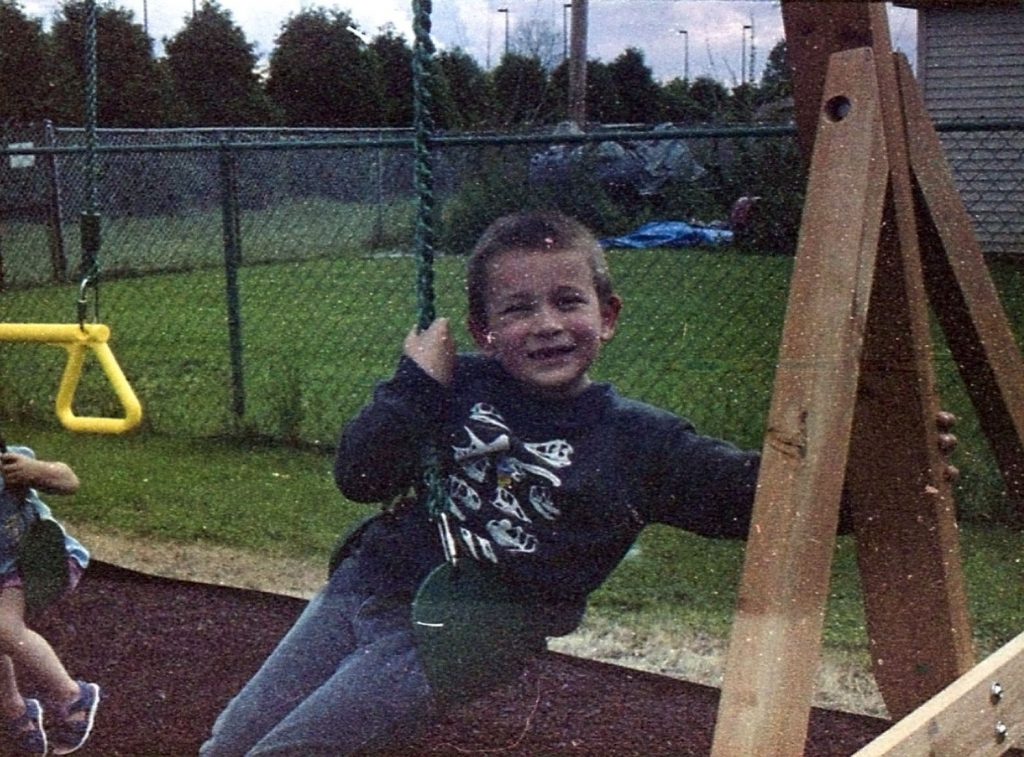
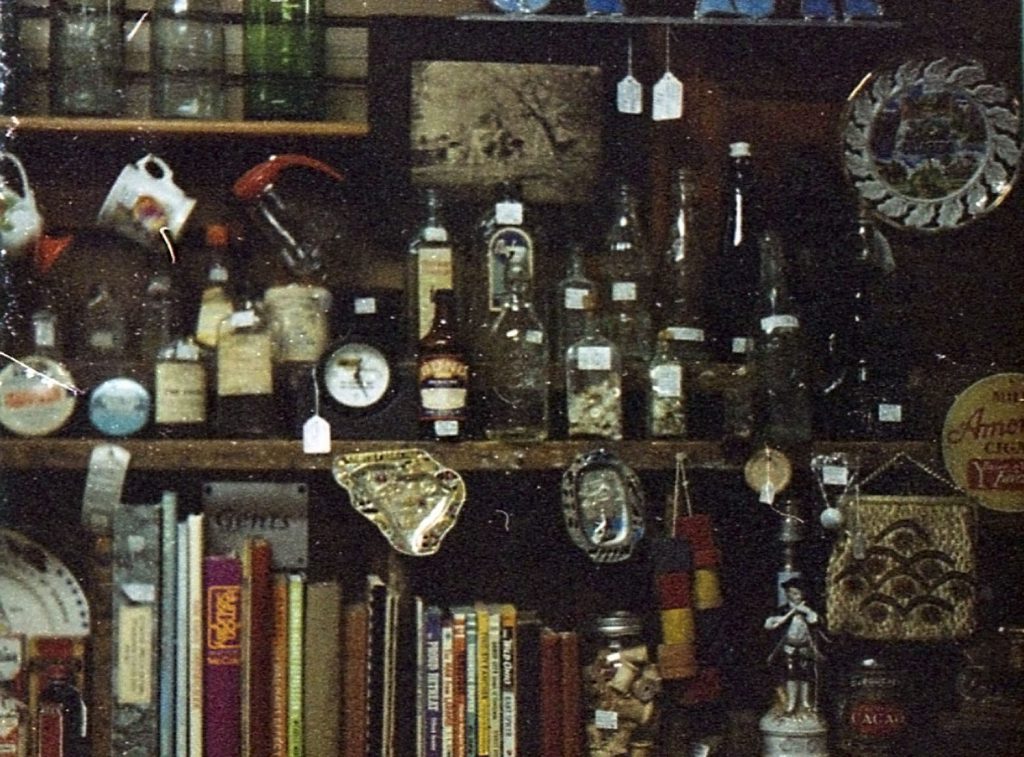

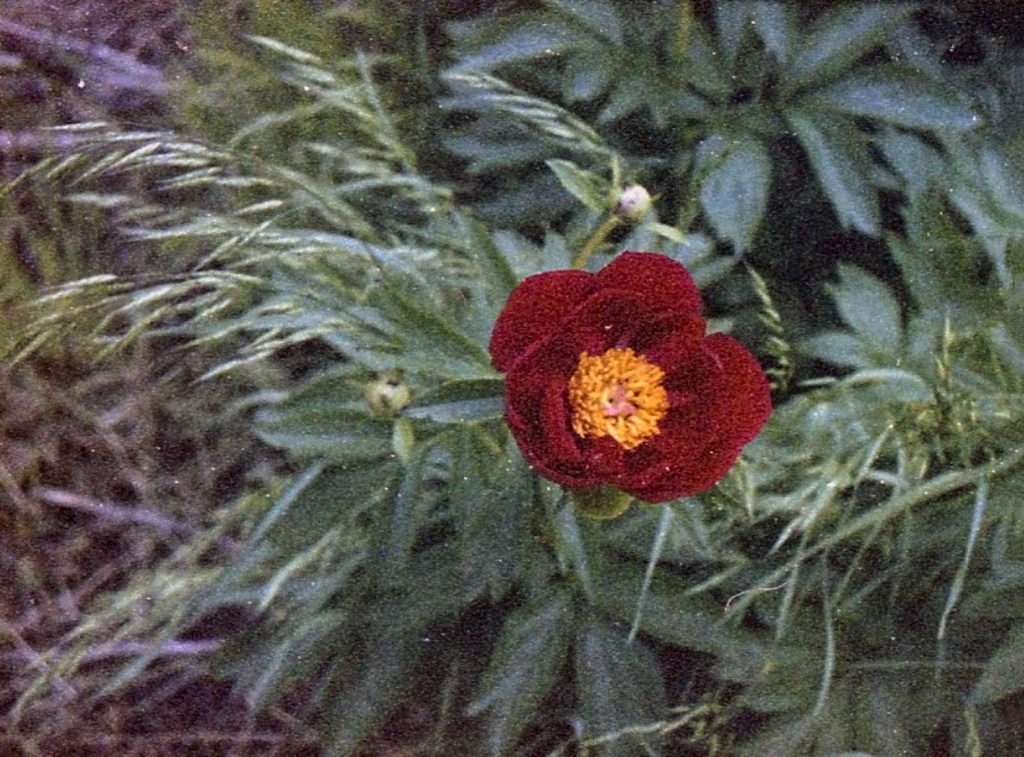
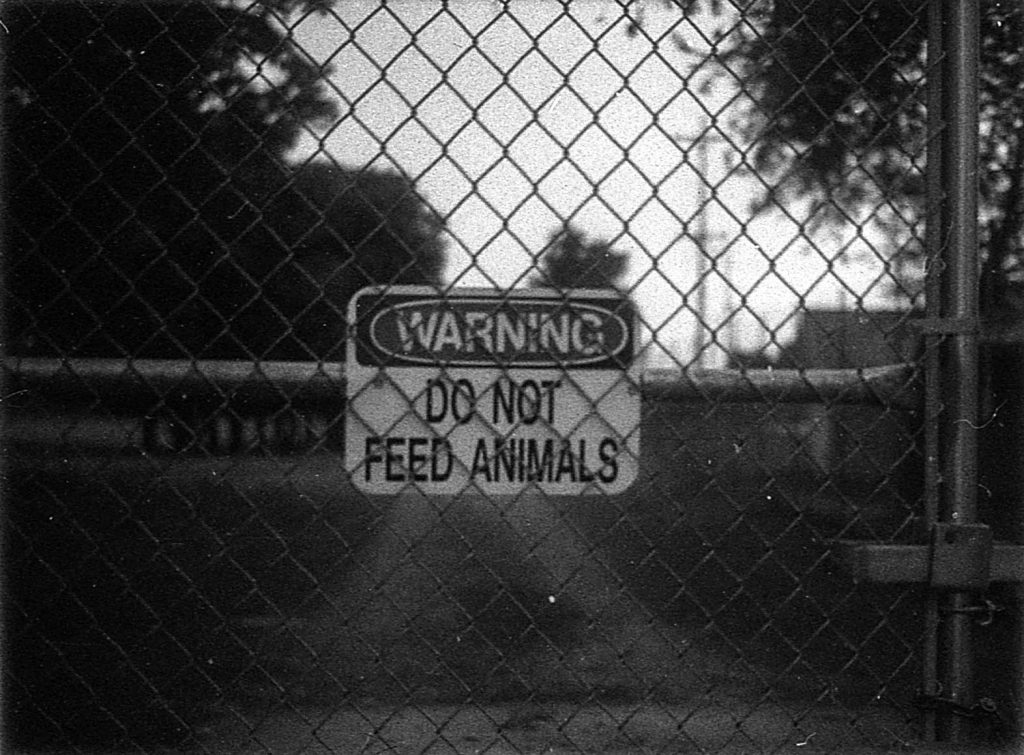
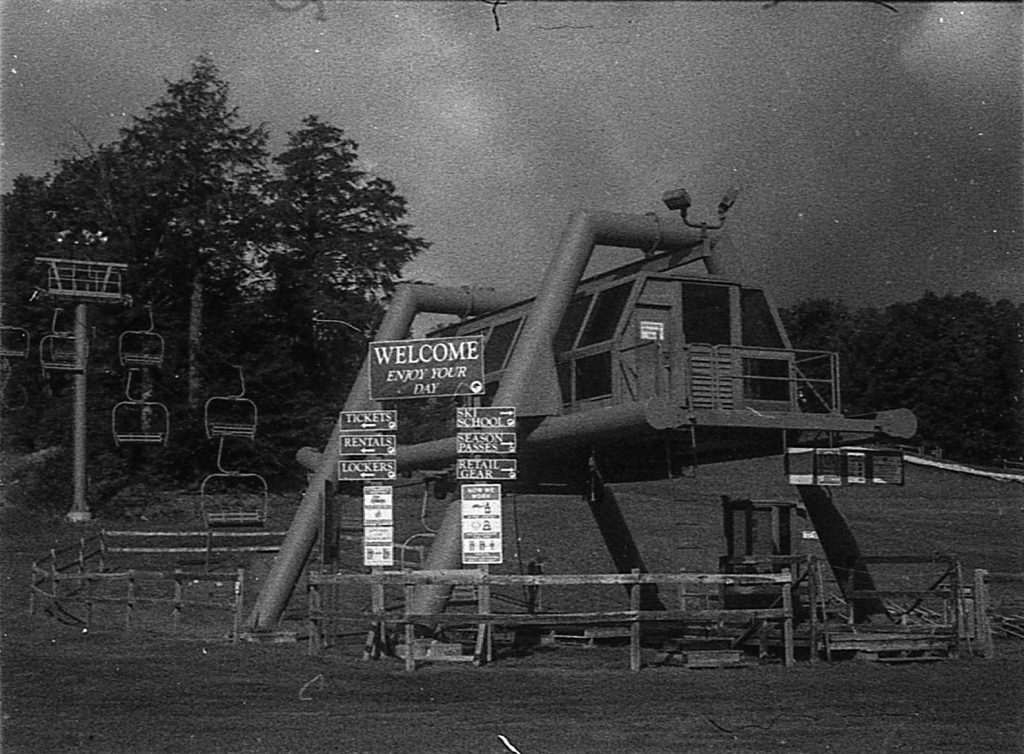
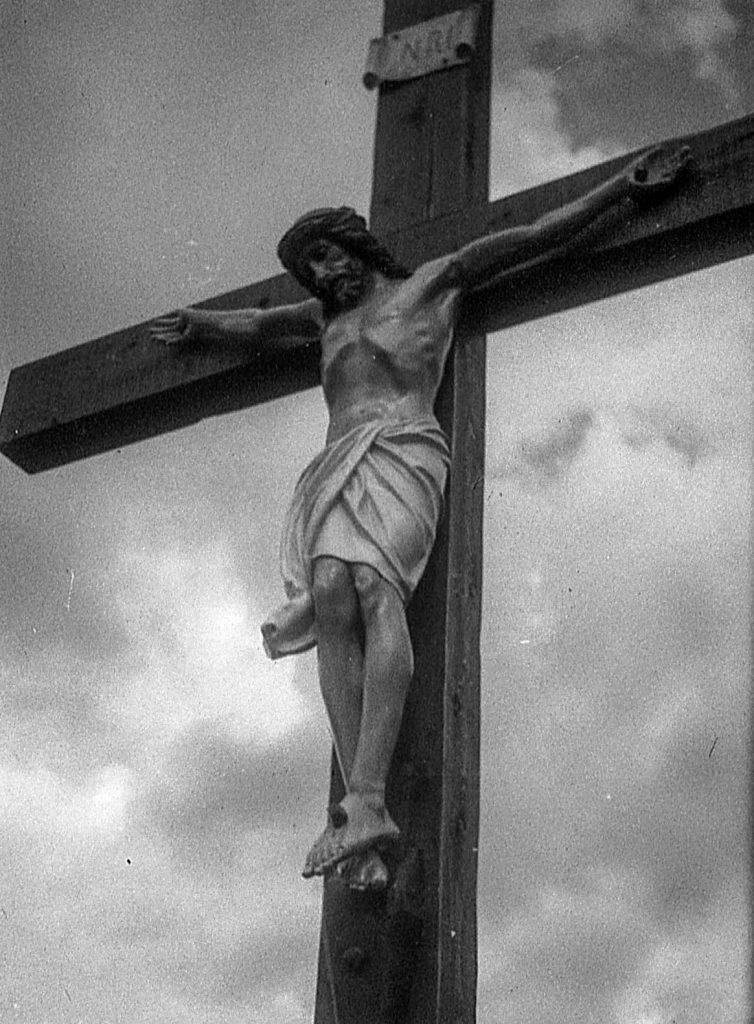
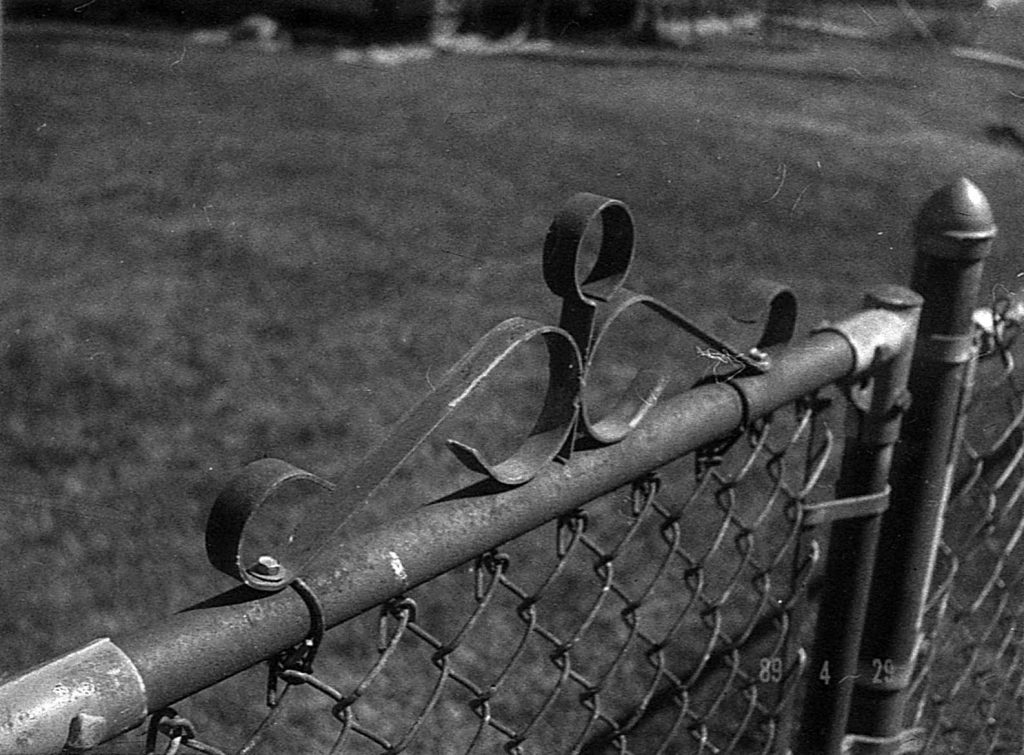
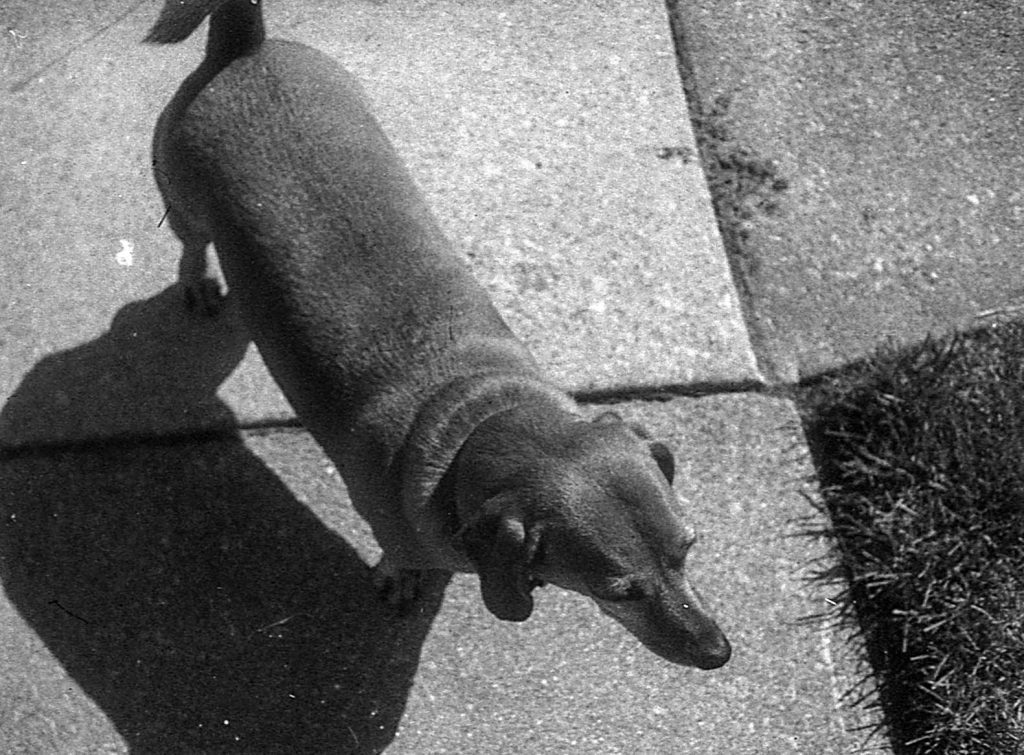

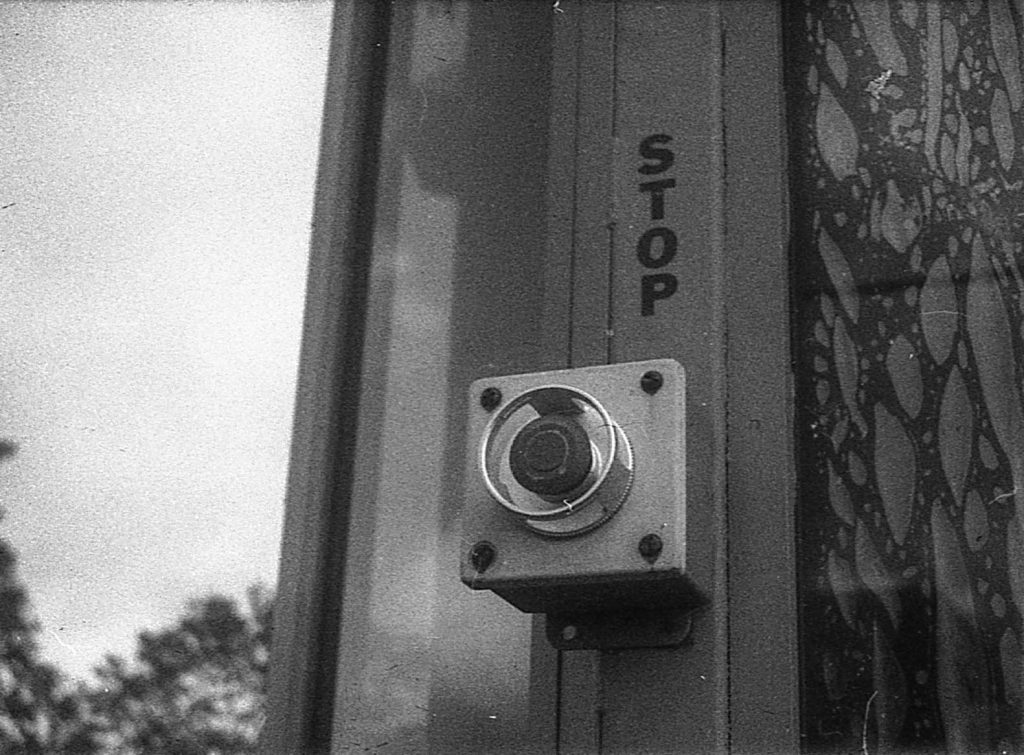
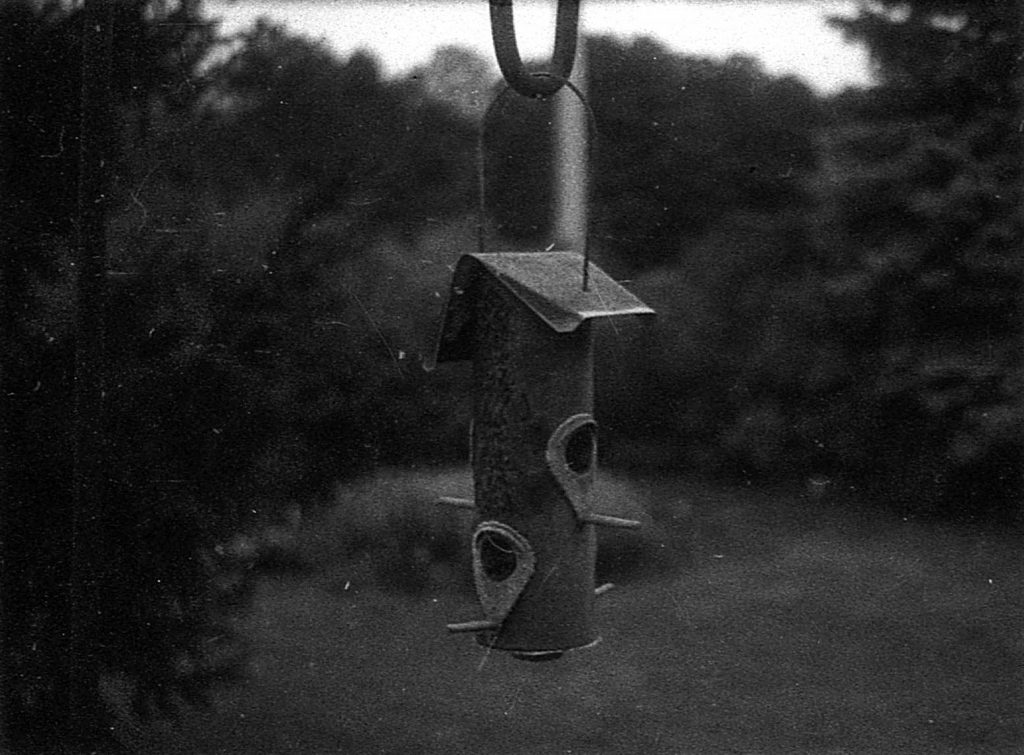
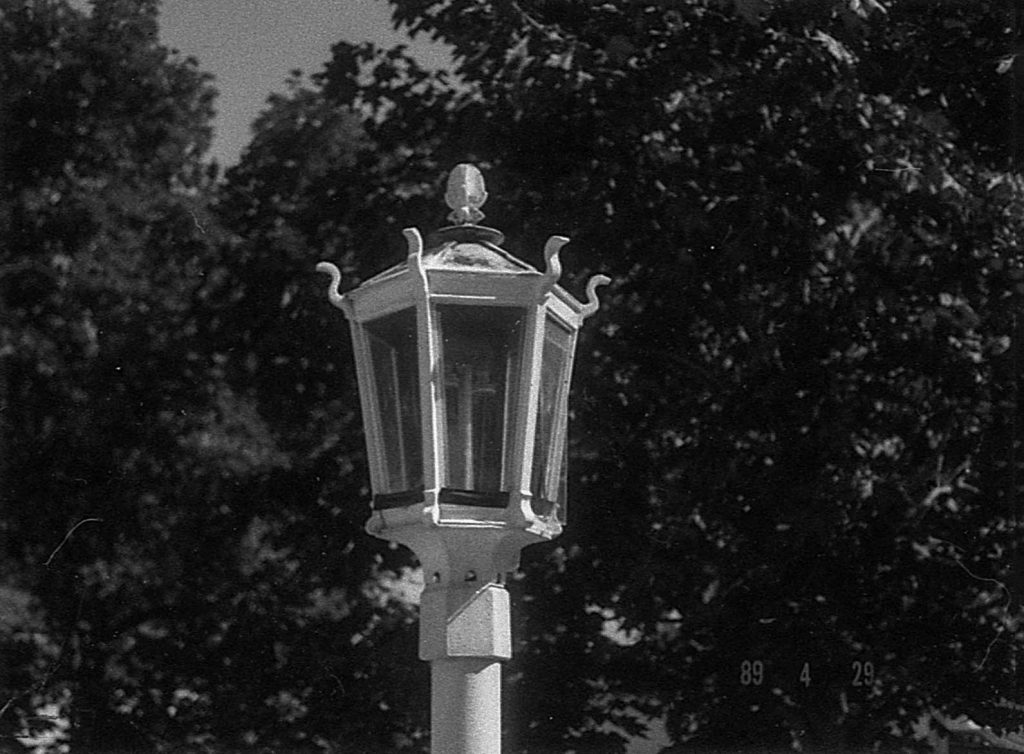
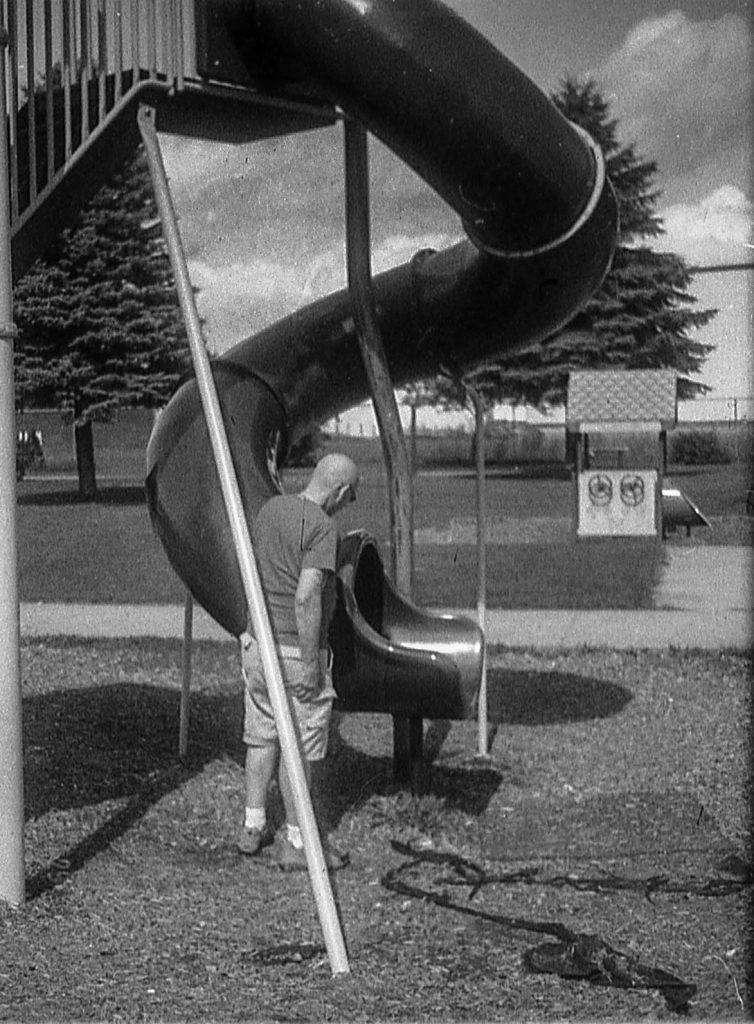
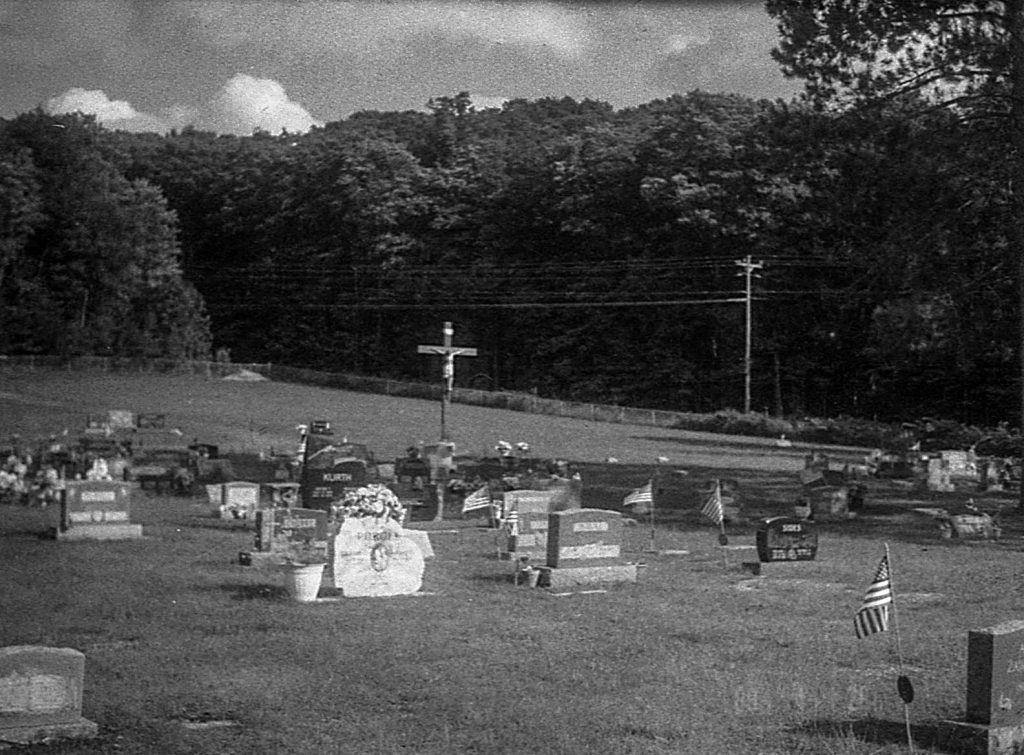
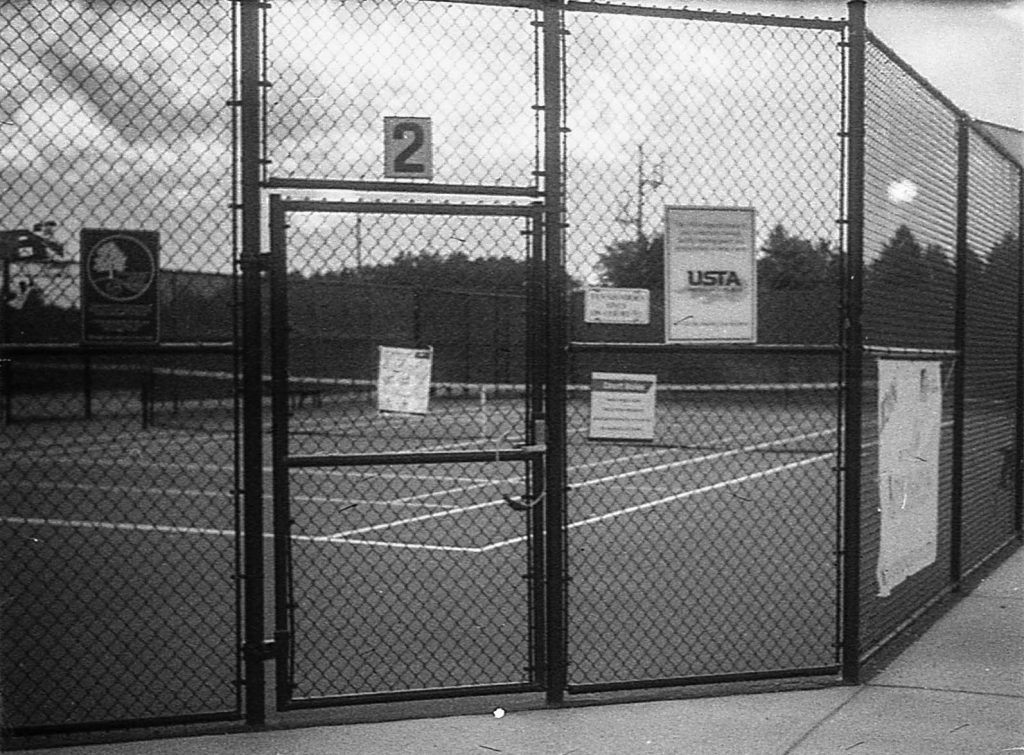
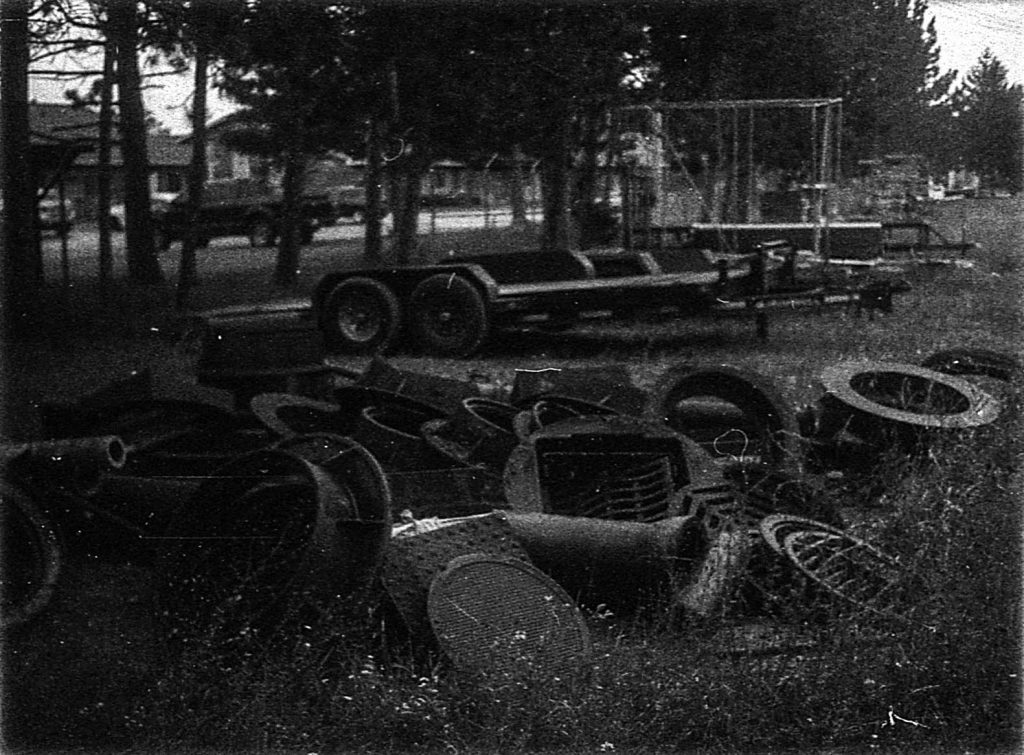
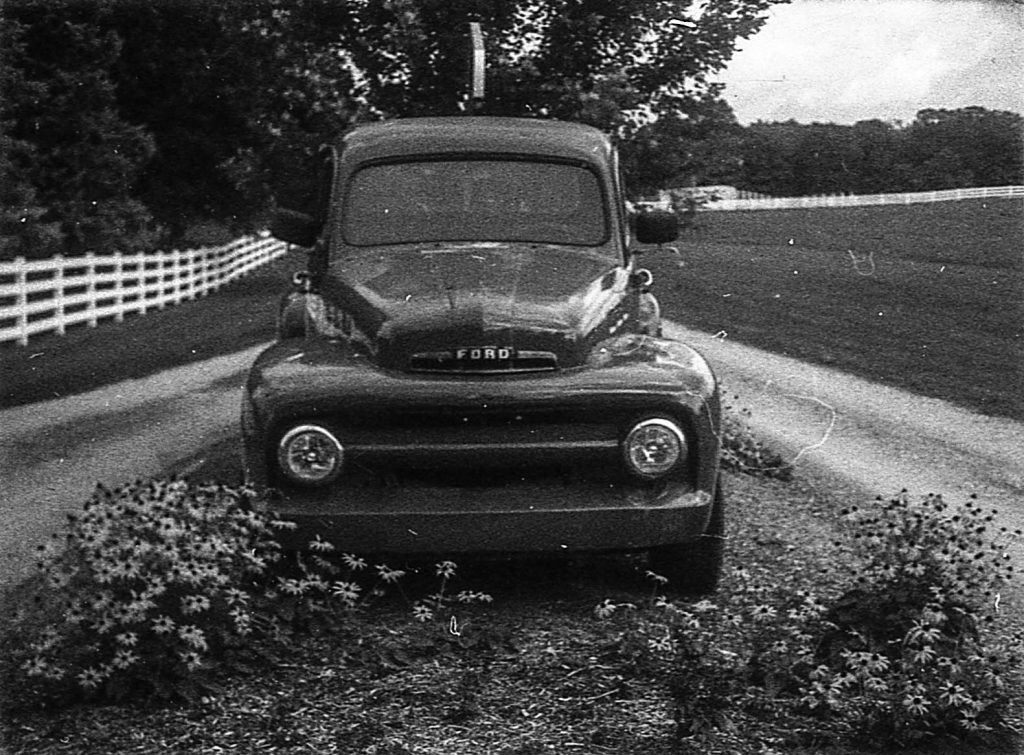

I’ve just been using mine, too!
Mike, I just happened to read this Canon 110ED-20 review again and have a couple notes for your consideration. First, The Fukkatsu films weren’t all carefully protected before sale. I have some color cartridges from FPP that are off-color, likely a storage prpblem. Second, the Fukkatsu B&W “ISO 100” cartridges were ALL keyed for 400 film, though it was a 100 film. So your 110ED-20 probably didn’t get a fair shake in the exposure department.
I reload my 110 cartridges, usually with ORWO UN54 and generally get very good results. If you wish to try again with another review, I can provide a coiuple cameras and UN54 carts, provided you share the results.